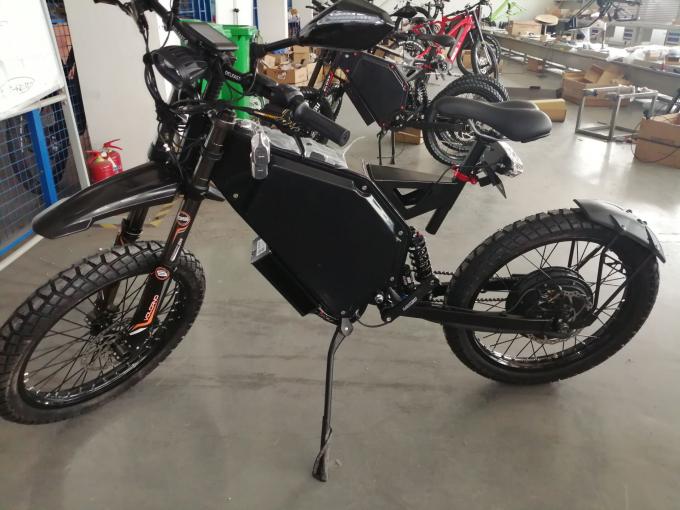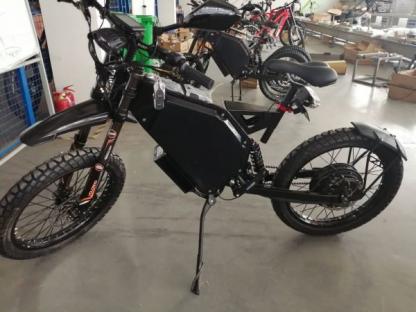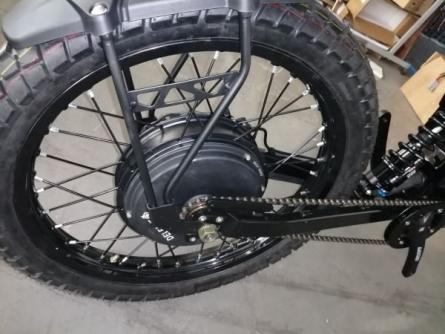
Electric Bike Care Tips
Have you noticed that a dirty car is driving worse and a messy computer is working worse? If you think that it is just your emotional perception, then you are mistaken. The smallest dirt or dust can become fatal for electronics, and a weakly tightened nut in a car can be fatal not only for the car but also for life. However, all this applies to any transport, including bicycles. And especially e-bikes, which combine the typical vehicle design and the addition of electronics, which means they also accumulate typical vulnerabilities for these parts. Today we talk a bit about caring for an electric bike – with the example of Delfast Top 2.0.
A few words about DELFAST Top 2.0
This is the flagship model in the Delfast line of electric bikes. It is the most expensive, but at the same time, it is the most technically advanced, powerful and fast. The maximum speed is 80 km / h!

Customization for your needs.
Before starting a ride, any cyclist should always start by adjusting his seat: seat → legs → handlebars → mirrors. You need to make sure that the wheels are not going to fall off, that they are turning, etc. You need to adjust the position of the saddle and steering wheel, as well as all the handles / switches on it. An improper adjustment of seat in a car can be neglected to a certain degree, yet in a bicycle – it is way more important – for the fatigue of the back, legs, wrists, neck. And, ultimately, security.
There are several methods for adjusting the height of the saddle (search for the methods of Holmes, Lemond, 109%), but the most common is the “heel method”: sitting straight on the saddle, in the pedal’s lower position, your leg should be fully bent at the knee.
The fact that something is wrong with the steering angle will become clear after a long trip. The angle must be set so that during the movement the wrists do not “bulge” and do not strain when switching speeds and braking.
And, the last thing: adjust the stiffness of the front shock absorber. It so happens that the fork travel is so large and light that when braking with the front brake, you can easily execute a triple somersault over your head.

A modern bicycle (and even more so an e-bike) is a complex technical mechanism. And it, like any other mechanism, needs maintenance. In this regard, it is not much different, for example, from a motorcycle or a scooter, upon purchase of which you will be given a service book with a regulated maintenance routine. Change oil, filters, pads, discs, candles, shock absorbers, belts / chains, etc. – during operation, everything wears out or breaks, everything has its own service life.
With an electric bike, the maintenance is even easier than with mechanical transport. Things need to be changed not so often because there are practically no complex mechanical components such as an engine or transmission, and electronics and electric motors are very reliable – therefore, in most cases, you can get off with simple maintenance. Almost all the work does not require any special tools – a set of keys / hexagons / screwdrivers is enough.
In a good way, it is necessary to check / maintain the components of the electric bike before each exit, namely:
Tire pressure (for MTB at least 2 atmospheres)
Chain condition (contamination, lubrication, interference)
Brakes (condition of disc and pads, clearance adjustment, condition of hydraulic lines, handles)
Wheel mounting (pulling eccentrics), steering wheel and saddle
Backlash (steering wheel, bushings, carriage assembly, connecting rods)
Battery Charge
Below we talk about the main problems and how to solve them.
Chain
There are at least two reasons to lubricate a chain with a certain periodicity: 1) so it will last longer and 2) so it will work quieter, without unnecessary creaks and clanks. With active riding, it is advisable to lubricate the chain once a week. Even if you ride using only the throttle stick, water, dust and dirt get on the chain and it can break down. Therefore, the chain must be cleaned periodically. To clean the chain, you can use special brushes, but you can do with an ordinary rag. Then you need to take an oiler (as an option – a syringe with a thin needle or an aerosol), place it over the chain and squeeze it gently (so that the oil drips, but does not flow), while simultaneously pedalling (so that the chain moves). After lubricating the entire chain, it is advisable to spin the pedals for a couple of minutes, and then remove all the “excess” with a dry rag / napkin.
Do not forget that the chain is replaceable. Therefore, if everything has rusted after the winter, it is easier to replace the chain, rather than engage in resuscitation. The resource of the chains is different, on average 1000-2000 km, to determine the level of wear there is a special tool – a chain meter.
The brakes
There is an opinion that the brakes were invented by cowards, and the bike should ride at idle speed. That may be so, but still in our time it is better when complete order with the brakes is one of the key components of your (and those around you) safety.
Now there are two brakes on bicycles and they should work properly. Therefore, do not forget to monitor their condition – if the bike does not brake well, then you cannot pull it off.
All Delfast electric bikes have disc brakes. The brakes are installed “from the factory” even when the e-bike is purchased disassembled, and therefore “out of the box” they are set up (you only need to adjust the position of the brake levers on the steering wheel). But the nuances may appear during operation. The most common problem is the creaking of the brakes (even if you just drive, not brake). If the creak appeared suddenly, then most likely the dirt got into the brake mechanism, But if suddenly something like oil got onto the brake pads (and first onto the rotor) (for example, from a leaked fork), then you just have to disassemble / clean or buy new pads. If the creak is constant, then something is rubbing on something – the brake disc is on the pads, or the pads on the disc, Both options do not benefit either the disc or the pads. The solution is simple: adjust the clearance between the brake disc and calliper, for which there are several bolts on the latter. Important: the gap between the block and the rotor should not be very large, otherwise the braking will be less effective. Worst case: a deformed brake disc (for example, as a result of a fall) – here, adjustment is unlikely to get by. To solve the problem, you will need a special key for editing disks, or a rotor replacement. It is sometimes possible to detect curvature “by eye”, in other cases it is enough to turn the wheel of the raised bicycle. With the rear brake, the situation can be more complicated, because a motor is installed on the rear wheel, and you may not be able to service the brake yourself and you will need a visit to a specialized workshop. In addition, due to the recuperation, Delfast e-bikes are braked by the engine, which significantly extends the life of pads and discs.
And the most important detail of any electric bike – the battery.
The battery is not only an important component of the electric bike, but also the most expensive one as we wrote earlier. Delfast electric bicycles use lithium-ion batteries assembled from elements manufactured by Panasonic.
Key tips:
Do not overheat.
Do not allow full discharge.
Once every 3 months, discharge and charge the battery
Use original charger
And add a few more words:
Delfast bicycles use high-quality batteries and controllers for them, while charging provides protection against overvoltage, overcharge, overdischarge, overload, circuit, overheat, reverse polarity. Therefore, it remains only to monitor the state of the battery outside of travel.
With prolonged inactivity (for example, if you do not ride in the winter and in the off-season), if you store your bike in a cold garage, it is advisable to remove the battery and store it at home in a half-discharged state at a temperature of 15-20 degrees.Try not to ride at temperatures below -10 ° C.
Hygiene
It is hardly worth talking about how dirty a bicycle can be, even if you ride it in dry weather and on asphalt. Not to mention rainy weather and land. Let’s start with the fact that it is absolutely impossible to wash an electric bike. HPD – High Pressure Apparatus, which includes all kinds of equipment for car washes, when used has a stream of water that easily seeps through even the smallest crevices and openings, although at low pressure it can easily damage not only the electric but even less sensitive components. Therefore, it’s better to cross out the option “stop in for 5 minutes in a car wash and wash everything” – even if everything works after washing, it’s not a fact that this will take a long time. If water leaks into the motor wheel or the controller unit, then various side effects can occur only after a while. As a result: “5 minutes and washed” can easily turn into an expensive repair.
What then to use? As an option – use a medium-pressure apparatus. The meaning is the same – a hose under pressure, but not so destructive. The downside of this option is still the cost, well, and the “bulkiness” of the solution.
What can be washed in this case: a fork, brakes (and completely), the entire frame, rim and rubber. The chain, if clogged with dirt – carefully, so as not to wash off the grease from them, although it is still better to update it later. Even more accurately – the motor-wheel, but it is better not to touch it (like the controller). It is also advisable not to touch the attachments: flashlights, on-board computer, speed switches, etc.
The best, as it seems to us, option is to use removable full-sized wings so that a minimum of dirt flies onto the device; they can be washed even in the bathroom, even at the sink. And the rest – wet wipes. Yes, it will take more time, but you can “wash” anywhere: on the street, in the stairwell, but at least in the apartment. From the pros: firstly, it will turn out cleaner (rather than a jet of water), and secondly – wiping a centimeter by a centimeter, you can carefully monitor the status of all components and notice any anomalies in time (chips, scuffs, loosening, etc.)
If you just really need it, then it is better to call in for a self-service car wash and wash only the dirtiest items (for example, rubber-rim-spokes) with extreme care. But in no case do not give the bike to the washers, who in case of which will not incur any responsibility.
By the way, there is such a service as waterproofing electric vehicles. Usually, more compact vehicles (scooters, monowheels) are subjected to it, but it can certainly be done for a bicycle (more precisely, for its “sensitive” components). This may violate the guarantee (since it will take to analyze the “filling”), but if everything is done correctly, you can ride even under running water and cross small water obstacles. Right from the factory, Delfast bikes have a dustproof class – IP 54 moisture protection, which allows them to ride freely in almost any weather, but, as we know, there is no limit to perfection.